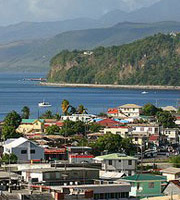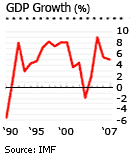Improving economy seen for the Dominican Republic

The Dominican Republic is recording a modest economic upswing in 2010 after feeling the effects of the global crisis—the economy continued to grow, but slowed down as tourism numbers, remittances and exports fell, affected by the US recession. Despite this, the Dominican Republic continues to be the Caribbean region’s largest economy and top tourist destination.
With an uptick in tourist arrivals and the GDP, Dominican realtors are hoping that the property market will begin looking up as well.
The economy is looking up

Both the ECLAC (Economic Commission for Latin America and the Caribbean) and the IMF forecast 6% GDP growth for the Dominican Republic for 2010, the best result in the Caribbean region. The prediction was made on the back of the country’s 7.5% year-on-year GDP growth in the first half of 2010. Furthermore, free trade agreements with the US and Central America (DR-CAFTA) and the European Union (EPA) have increased Dominican activity in international trade. The country is presently conducting similar free trade talks with Canada and Taiwan, hoping for an additional boost in investment and exports.
However, the country still has huge hurdles to clear before lasting progress can be made. A vast gap between rich and poor, a high unemployment rate, government corruption, and constant power outages continue to be big problems for the Dominican Republic. Most worryingly, and despite the country’s growing economy, around 48% of the population live below the poverty line.
The Caribbean’s top tourist draw

The Dominican Republic is the top vacation destination in the Caribbean, usually having the largest number of tourist arrivals in the region by a considerable margin. So far this year the country has enjoyed a modest 3.9% growth in tourist arrivals.
Tourist-friendly developments are more concentrated in the eastern and northern regions. Southern areas such as Barahona and Pedernales are less developed and less visited, but there have been efforts made to promote them as eco-tourism destinations.
Foreign buyers for homes on the coast

Some of the most desired residential areas in the country are in tourist hot spots such as the capital, Santo Domingo, and the areas on the country’s beautiful Atlantic coast, such as the tourist towns of Sosua and Cabarete, the peninsula of Samaná, and Puerto Plata. Luxury beachfront apartments in places such as Punta Cana and Bavaro, Las Terrenas and Boca Chica have gone up in recent years.
One of the most high-profile developments in recent years has been the Cap Cana project on the east coast, a high-end residential and tourist mixed development of hotels, oceanfront homes, golf courses and commercial establishments.
Realtor Josefina Covents of the Cabarete-based agency Josefina Covents y Asoc sees the housing market growing next year. “We in the Dominican Republic were some of the last ones to feel the global crisis , so we’re some of the last ones to come out of it,” she says. “Property prices have had ups and downs this year as a result of people needing money. But a lot of owners are saving their property to put on the market next year, when they can sell it at the price they want.” Covents anticipates that interest should start rising during the tourist season—from mid-December to April—so there should already be increased activity by the end of the year.
There are no restrictions on foreigners’ buying property in the Dominican Republic. This is a good advantage in popular holiday towns like Cabarete. “Tourists come for the surfing and the windsurfing, and many of them end up buying homes here too,” says Covents. She adds that the tourist towns have seen a subtle shift in buyer demographic over the years. “Before, about 80% of our buyers were Europeans, mostly Germans and Swiss, and some Canadians. Now, the number of buyers from the U.S. has increased, as well as those from Eastern Europe and other parts of the world.”